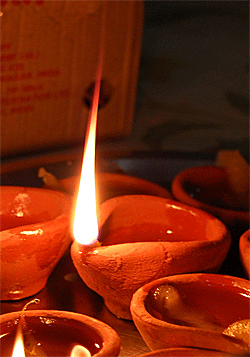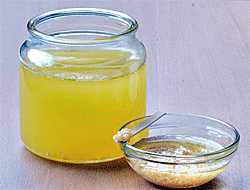GHEE, clarified butter: food and medicine
by Violeta Pîrvu, M.D.
specialist family physician, apitherapy, phytotherapy, AYURVEDA
Ghee, which is called GRITA in Sanskrit, known by Europeans by the name of clarified butter, is both a food and medicine, often used in Eastern cuisine, especially Indian. It represents an important ingredient of traditional Indian medicine AYURVEDA (with an over 5000 year old tradition). Its extremely powerful properties make him superior to ordinary butter from a nutritious perspective, and traditional AYURVEDA medicine recommends ghee for a variety of affections and health issues.
 Ghee – “the sacred food” in Hindu tradition
Ghee – “the sacred food” in Hindu tradition
Ghee is considered to be “the food of the gods”. It has a sacred role in the Hindu religion, used in religious rituals. Dripping melted butter into the ritual fire is a symbol for the maintenance of the sacred fire AGNI, bearer of life. In Hindu mythology it is said that PARJAPATI, supreme Hindu goddess, has created ghee by rubbing her palms together. By dripping ghee in her sacred fire, AGNI, she created her sons, thus ensuring the continuity of life.
The difference between ordinary butter and ghee
There is a fundamental difference between ordinary butter and clarified butter or ghee. When preparing clarified butter, water and proteins as well as some fats are eliminated. The only thing that remains is pure fat and thus we obtain a product which is superior to ordinary butter. The ghee which is properly cooked does not become rancid, it does not decay and it can be kept in room temperature for weeks or even years, without losing its qualities. As a matter of fact, ancient ayurvedic texts say that the older the ghee (clarified butter) is, the more “aged” it is, the more value it has, from a therapeutic perspective, being used in healing many affections.
How do you prepare ghee?
Ghee is prepared from unsalted cow butter, which has plenty of fat, preferably without any food additives. You place the butter in a stainless steel cooker and melt it slowly above a light fire. After it melts, the water will begin to emerge as a white-yellow foam. You will have to remove this foam with a spoon. This process will keep on all along the process of obtaining the ghee. In the first minutes of boiling, melted butter contains many white flakes which represent water and certain protein and fat from the milk. They will eventually separate from the ghee.
During the formation process, these flakes will either be deposited at the bottom of the cooker (in the form of a brown deposit which will bind to the bottom of the cooker) or they will dissolve in the foam forming at the surface of the fluid. At some point, after the elimination of the residual components and water, the clear separation of ghee will occur, in the form of a bright yellow fluid, clear, transparent, with no flakes inside. Now you can take the cooker off the fire and filter it through a cheesecloth. This way you will remove any foam traces and residues.
You will then place the liquid in a jar with a cap and you will keep it in room temperature until using it. If all the water and protein residues have been eliminated from the butter, you do not have to keep it in the fridge. This aspect will also prove to that the ghee you prepared is genuine. Ancient ayurvedic texts say that well prepared ghee from a quality butter can go on even for a hundred years in room temperature without going bad.
 What about its therapeutic purpose?
What about its therapeutic purpose?
– Tonic, rejuvenating, nutritious (ayurvedic texts say that “it nourishes all the tissues and organs”)
– Anti-anemic
– Detoxifying (stops toxic accumulations called “AMA” in AYURVEDA medicine)
– Antidote in case of poisoning
– Decreases cholesterol levels
– Stimulates digestion
– Decreases gastric acid
– Recommended for chronic cough, bronchitis and asthma (together with certain plant mixtures)
– Recommended for bile conditions
– Recommended for insomnia – one teaspoon of ghee with warm milk in the evening induces sleep naturally
– Recommended in epilepsy and memory loss
– Used in skin affections
– Lubricates skin and mucous membranes, makes hair, nails and skin glow if used regularly.
Ghee is a basic element used both in the preparation of therapeutic remedies in AYURVEDA medicine, as well as for body purification processes, called PANCHAKARMA within the same AYURVEDA system.
How to use ghee in alimentation?
Indian cuisine uses ghee in cooking and roasting foods, its digestive properties (easy to digest, stimulates digestion and absorption of certain nutritious principles) making it indispensable from all kinds of foods. In India, children are fed a teaspoon of ghee daily both for stimulating their physical growth and development and for increasing their intelligence and memory.
yogaesoteric
april 2015


